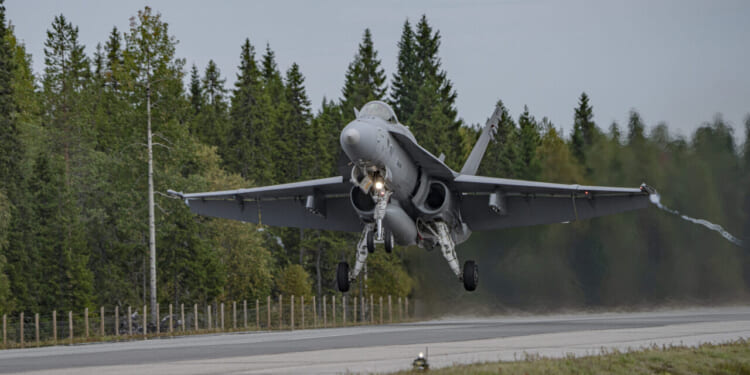Training events like these give pilots, maintainers, and commanders the necessary skills and confidence to conduct effective ACE operations.
Highly advanced fighter jets landing on public highways is an unusual sight. But this is how NATO plans to fend off a Russian attack in its northern flank.
F/A-18 Hornets on Estonian Highways
In October, Royal Canadian Air Force F/A-18 Hornet fighter jets deployed to Estonia as part of a large-scale NATO exercise and conducted Agile Combat Employment, or ACE.
Eight Canadian CF-188 Hornets landed on the Jägala-Käravete highway, part of the longer Piibe highway in Estonia. In addition to the Canadian fighter jets, an Estonian M-28 Skytruck transport aircraft and Italian Eurofighter Typhoons also conducted landings on the public highway.
Calling the operation a “historic first,” the Royal Canadian Air Force highlighted on a post on X that the ACE attributes of the exercise, stating that “this marks the first highway landing for Canada’s Fighter Force, showcasing the ability to operate in austere environments and rapidly redeploy.”
The landings were part of the wider Exercise Tarassis 2025, a joint, multi-domain exercise among 10 NATO members in Scandinavia, Eastern Europe, and the Arctic Circle.
In addition to the Canadian fighter jets, Estonian M-28 Skytrucks and Italian Eurofighter Typhoons also conducted landings on public highways.
CF-188 is the Royal Canadian Air Force’s designation for the US-made F/A-18 Hornet.
The US military often conducts ACE operations with several different airframes, ranging from F-35 Lightning II stealth fighter jets to A-10 Thunderbolt II close air support aircraft. The Swedish and Finnish Air Forces are also quite proficient in ACE operations with JAS 39 Gripen and F/A-18 Hornet fighter jets, respectively.
ACE Operations
ACE is a concept designed to deliver air power to the battlefield while at the same time minimizing the threat to fighter jets.
It is no secret to the Russian or Chinese military where US and NATO air bases are located, and which units and aircraft are assigned where. Thus, in the event of a near-peer conflict, it is almost certain that the Russian or Chinese military would try to attack these bases at the outset of the fighting to hamstring US or NATO air operations. A “Pearl Harbor” moment could give Russia or China an advantage over subsequent fighting. The development of increasingly advanced munitions, including hypersonic missiles, makes such strikes possible even in the face of robust air defense umbrellas.
One way to ensure that a near-peer adversary will not be able to seriously degrade US or NATO air power capabilities with a preemptive strike is through ACE operations.
Spreading fighter jets and support personnel across the battlespace would make it almost impossible for an adversary to take out a significant number of aircraft with missiles or airstrikes. But to do ACE operations, militaries need to have the right aircraft and also practice during peacetime. Landing on highways is not the same as landing on proper runways. Moreover, not all highways are created equal. American highways tend to be larger than European or Asian ones.
Training events like Exercise Tarassis 2025 give pilots, maintainers, and commanders the necessary skills and confidence to conduct effective ACE operations.
About the Author: Stavros Atlamazoglou
Stavros Atlamazoglou is a seasoned defense journalist specializing in special operations and a Hellenic Army veteran (national service with the 575th Marine Battalion and Army HQ). He holds a BA from the Johns Hopkins University and an MA from the Johns Hopkins’ School of Advanced International Studies (SAIS). His work has been featured in Business Insider, Sandboxx, and SOFREP.
Image: DVIDS.


















